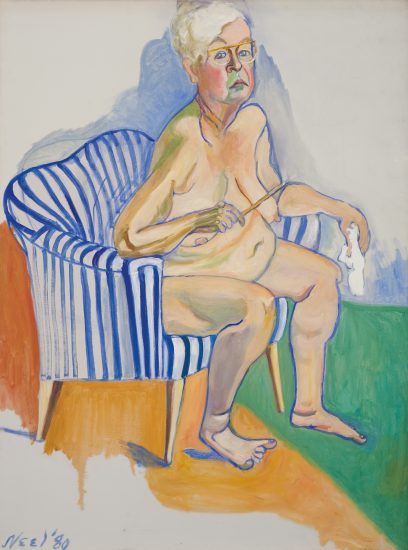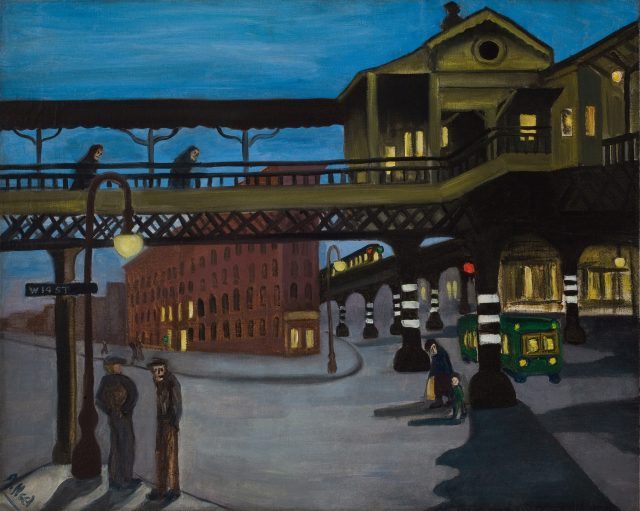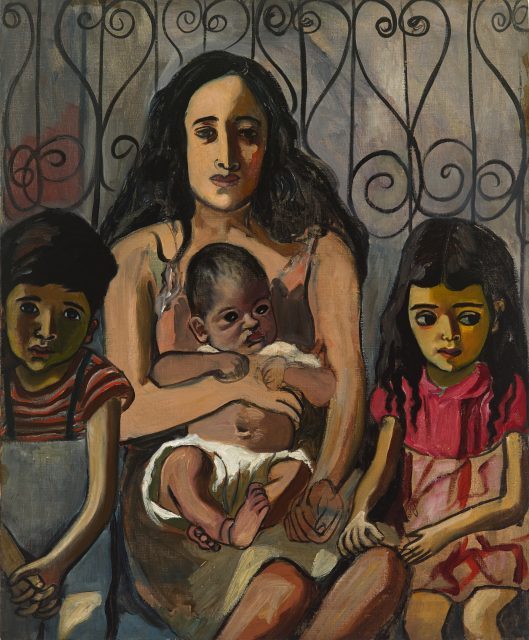
Alice Neel, Self‑Portrait, oil on canvas, 1980 (National Portrait Gallery, Smithsonian Institution, Washington, DC / © the Estate of Alice Neel)
ALICE NEEL: PEOPLE COME FIRST
Met Fifth Ave.
1000 Fifth Ave. at 82nd St.
Through August 1, pay-what-you-wish to $25
www.metmuseum.org
I well remember going to El Museo del Barrio for its fortieth anniversary reopening back in the fall of 2009 after an extensive renovation. I was blown away by the centerpiece of the exhibition “Nexus New York,” a section devoted to the relationship between American painter Alice Neel and Cuban artist Carlos Enríquez, who were married in 1925. Neel is now the subject of a revelatory show continuing at the Met Fifth Ave. through August 1, “Alice Neel: People Come First,” which focuses on her portraiture, from the men in her life to the women and children who evince the beauty and fragility of pregnancy and motherhood.
Neel was born in Merion Square, Pennsylvania, in 1900, lived with Enríquez’s family in Cuba for a short time, then came back to America, where she resided in Greenwich Village before moving to Spanish Harlem for more than two decades. She had two children with Enríquez: Santillana, who died of diphtheria before the age of one, and Isabetta, who Enríquez took back to Cuba when he left Neel in 1930. A few years later, after Neel had a breakdown and spent time in a sanitorium, a relationship with sailor and heroin addict Kenneth Dolittle ended with his destruction of hundreds of her drawings, watercolors, and personal items. She attempted suicide at least twice. In 1939, she had a son, Richard, with the younger, married Puerto Rican musician José Santiago Négrón, following a 1937 miscarriage. In 1941, Neel had another son, Hartley, with Communist activist Sam Brody, whom she was with on and off for fifteen years.
Her biography is integral in appreciating the Met survey, which is expertly curated by Kelly Baum and Randall Griffey with Brinda Kumar. Stretching across eight thematic galleries, the show is filled with what Neel simply called “pictures of people” but were so much more than that, canvases alive with brutal honesty and an unwavering eye for personal identity. As she said in 1950, “For me, people come first. I have tried to assert the dignity and eternal importance of the human being.” In doing so, she also takes back the power of being a woman in what was deemed a man’s world, inherently battling discrimination, class and gender bias, and even, to a point, abstraction in portraits as well as still lifes, landscapes, and city scenes.

Alice Neel, Ninth Avenue El, oil on canvas, 1935 (Cheim and Read, New York / © the Estate of Alice Neel)
“Alice Neel: People Come First” is divided into “New York City,” “Home,” “Counter/Culture,” “The Human Comedy,” “Art as History,” “Motherhood,” “The Nude,” and “Good Abstract Qualities.” Her unflinching works do what only the finest portraits do, whether the realism of Hans Holbein, the idiosyncratic nature of Pablo Picasso, the elegance of John Singer Sargent, the royal gaze of Diego Velázquez, or the reimagining of the Old Masters of Kehinde Wiley. “One of the reasons I painted was to catch life as it goes by, right hot off the griddle, because when painting or writing are good, it’s taken right out of life itself, to my mind,” she says in a passage on the audio guide taken from an old interview. “The road that I pursued, and the road that I think keeps you an artist, was that no matter what happened to me, you still keep on painting; you just should keep on painting no matter how difficult it is, because this is all part of experience, and the more experience you can have, the better it is, unless it kills you, and then you know you’ve gone too far.”
The show consists of more than one hundred of Neel’s paintings and drawings, displaying her immense skill at creating compelling, intensely psychological narratives out of the every day. In 1933’s Investigation of Poverty at the Russell Sage Foundation, painted when Neel was employed in FDR’s Public Works of Art Project, a woman dressed in black, a homeless mother of seven, sits in the center of a room, head bowed, hands held up to her face, as ten men in suits, two women, and a priest are gathered around her, unsure if there is anything they can do to help her. The painting is accompanied by a rare preparatory sketch of two of the men, who themselves have come to ask for assistance from the foundation. In the same year’s Synthesis of New York — The Great Depression, which had been slashed by Dolittle but was repaired, men, women, and children with skulls for faces walk under the el train as two angelic mannequins, one headless, perhaps from the commercial building at the middle of the canvas, hold up a sunlike object on a gray, cloudy day. In Thanksgiving (1965), a decrepit-looking turkey is in the corner of a kitchen sink as if just another object like the nearby can of Ajax. A trio of still lifes, including Black Bottles (1977), are bright and colorful, providing contrast to many of the darker works.
But it’s the portraits that are at the heart of the exhibition. Neel’s 1970 painting of Pop Art icon Andy Warhol shows the shirtless bon vivant sitting on a sketched couch, hands folded on his knees, eyes closed, breasts sagging, scars from his recent shooting clearly visible. In Kenneth Fearing (1935), the poet, novelist, and essayist, cigarette dangling from his mouth, dominates his surroundings like a giant, with a skeleton in the left of his chest because, Neel said, “His heart bled for the grief of the world.” Works such as Puerto Rican Girl on a Chair (1949), Mercedes Arroyo (1952), and Georgie Arce No. 2 (1955) capture the people in her neighborhood, from activist to kids on the street.

Alice Neel, The Spanish Family, oil on canvas, 1943 (Estate of Alice Neel / © the Estate of Alice Neel)
The canvases of pregnant women and mothers with their children are what take the exhibition to another level. There are no smiles in The Spanish Family (1943), in which Négrón’s sister-in-law, Margarita, is seen with her three children. A vertical painting of Isabetta from 1934-35 depicts the young child, not yet six, standing naked, defiantly with hands on her hips; it was painted from a photograph, as mother and daughter never had a close relationship. In a sign of the times, the wall label explains, “The frank nudity of the young child disconcerted viewers then and continues to raise legitimate questions now around consent and children’s bodily autonomy.” In Margaret Evans Pregnant (1978), a naked Margaret Evans, her belly bulging with twins, is on a gold duvet, staring at the viewer, part of her reflected in a mirror behind her. In the ink on paper Mother and Child (1956), a woman is lifting her blouse so her infant can suckle. The subject of Pregnant Maria (1964) evokes the classic reclining nude, as a naked woman, belly bursting, breasts swollen, reveals her body, flaunting her sexuality.
There are two paintings of Neel’s son Hartley, one from 1943, with a young, blue-eyed Hartley on a rocking horse, the other from 1966, with an assured, grown Hartley on a chair, wearing a T-shirt, his hands clasped on his head, his face very similar to a 1943 painting of her son Richard, also in a chair, his left leg crossed over his right. Neither appears completely relaxed or comfortable.
Three works explore Neel as a mother and a daughter. In the ink and gouache City Hospital (1954), Neel’s mother is hunched over in a wheelchair in a hospital ward in the last year of her life. In Well Baby Clinic (1928-29), Neel returns to the hospital ward for lower-class women where she gave birth to Isabetta; the two are in the far middle right amid swirling activity. And finally, in her 1980 Self-Portrait, Neel is fully nude, sitting in a blue-and-white-striped chair, holding a slender paintbrush in her right hand, a white cloth in her left. She leans forward, her sagging skin at the center of the canvas, her lips downturned, her feet at awkward angles on a floor separated into different colors. It took her five years to finish what would be her only painted self-portrait. “Life begins at seventy!” she once declared. Neel passed away in 1984 at the age of eighty-four, leaving behind a legacy that is well served by this extraordinary retrospective.
(You can watch several virtual programs about the show on the Met website, including “Alice Neel and Spanish Harlem or El Barrio” with artist Miguel Luciano and curator Susanna Temkin, “Hilton Als on Alice Neel” with Als and Baum, and “Alice Neel and Gay Liberation” with Griffey. In addition, the audio guide features contributions from artist Jordan Casteel and curator Jasmine Wahl.)